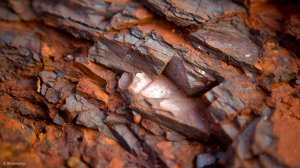JOHANNESBURG (miningweekly.com) – Brazilian and Australian iron-ore producers will continue to drive global iron-ore production, while Chinese firms lose market share owing to their position at the higher end of the cost scale, according to Fitch-owned market analysis company BMI Research’s recently published report on the global iron-ore industry.
The group noted that iron-ore producers worldwide would continue to face difficulties in maintaining profitability amid low iron-ore prices.
BMI added that, while the iron-ore price boosted miners’ profit margins in the first half of 2016, it expected prices to decline by the end of the year.
Prices are expected to remain subdued as iron-ore production oversupply persists, owing to expanding output from major producers, including BHP Billiton, Rio Tinto, Vale and Fortescue Metals Group.
In addition, the half-year price rally will slow consolidation among high-cost iron-ore producers, namely in China, which will result in a prolonged global iron-ore supply glut.
Despite this, BMI expects consolidation to ramp up over the coming quarters as lower revenues force producers to pursue a strategy of retrenchment and divestment of high-cost assets.
BRAZIL
According to BMI’s report, Brazil's iron-ore output will experience solid growth, supported by low production costs and a strong project pipeline over the coming years.
Production growth will largely be driven by Vale, which will remain the world’s largest iron-ore producer by volume globally to 2020. Vale's low-cost production base will ensure that the firm remains competitive in the current weak iron-ore price environment.
AUSTRALIA
Major iron-ore miners in Australia will push ahead with a pipeline of aggressive production plans over the coming quarters, despite subdued seaborne iron-ore prices. Declining production costs will maintain the economic sustainability of Australian majors’ strategy of increasing output to reap economies of scale.
BHP Billiton, one of the country's main iron-ore producers, reported cash costs for 2015 of $18 .7/t, down from $27/t in 2014.
Further, BHP and other major firms Rio Tinto and Fortescue Metals Group will continue to invest in existing operations.
Rio Tinto’s expected 2015 capital expenditure (capex) is reportedly $5.5-billion and it projects 2016 capex to remain under $6-billion.
SOUTH AFRICA
South Africa’s coal and iron-ore sectors will continue to be dominated by Anglo American, noted BMI.
However, as Anglo American is keen to offload most of its South African assets, this could result in a significant decline in the country's iron-ore production growth.
CHINA
China's iron-ore sector will become increasingly consolidated as low iron-ore prices sideline high-cost domestic miners.
According to Bloomberg Intelligence, around 70% of Chinese iron-ore output is uneconomical at prices below $96/t.
The Metallurgical Mines' Association of China says that the domestic iron-ore industry is highly fragmented, with at least 4 000 small and privately owned mining firms.
Fewer than ten companies have production capacity of ten-million tons or more a year, and these firms account for 15% of the country's total raw iron-ore output.
INDIA
India's iron-ore sector is dominated by public-sector undertakings, including the National Mineral Development Corporation (NMDC), Sesa Goa and Orissa Minerals.
Vedanta Resources' subsidiary, Sesa Goa, is the country's largest iron-ore producer and exporter from the private sector.
Essel Mining is one of the largest iron-ore mining companies in the non-captive private sector. Meanwhile, State-owned NMDC is India's largest iron-ore producer and exporter.
BMI believes that NMDC will hit its increased production targets, as a healthy financial position will allow it to ramp up capex.
Edited by: Samantha Herbst
Creamer Media Deputy Editor
EMAIL THIS ARTICLE SAVE THIS ARTICLE
To subscribe email subscriptions@creamermedia.co.za or click here
To advertise email advertising@creamermedia.co.za or click here













